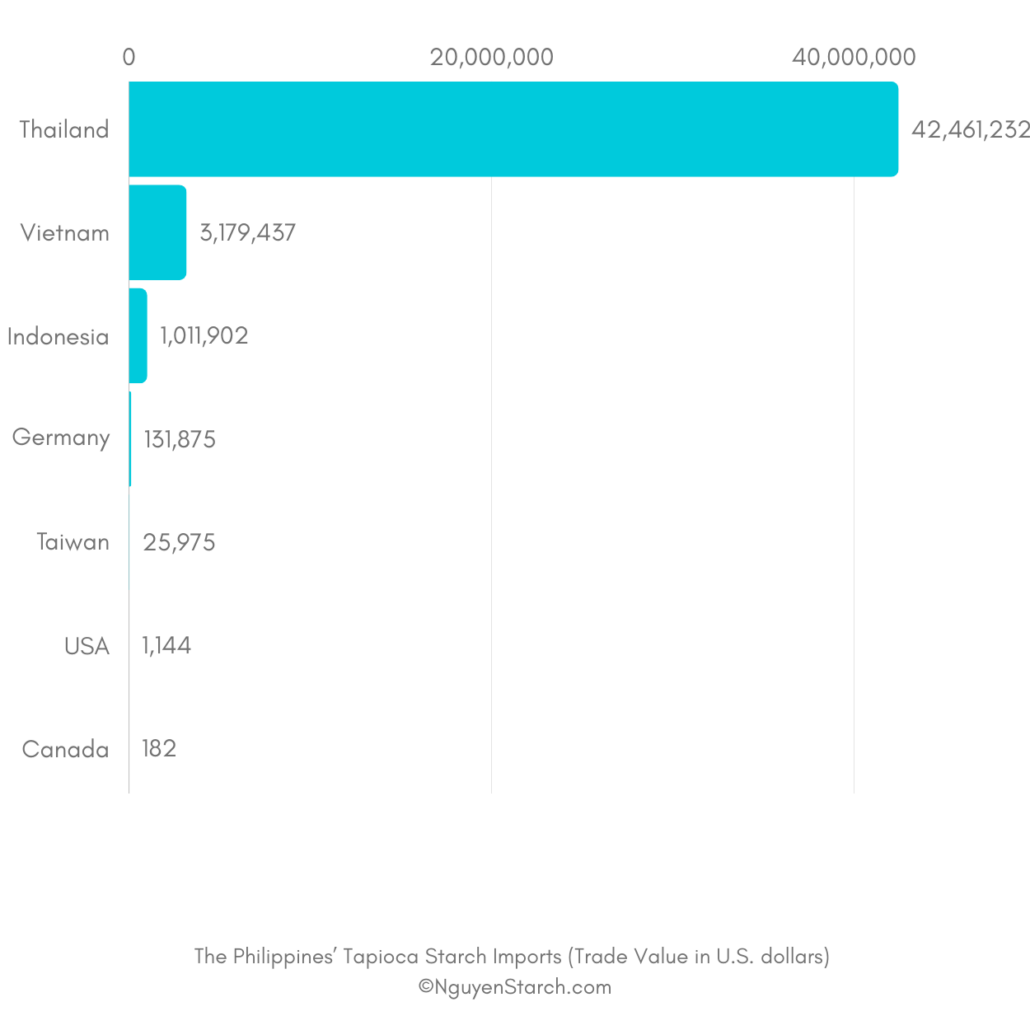The Philippines’ involvement in the tapioca starch trade reveals its role as both an exporter and an importer. As an exporter, the Philippines made modest contributions to the global tapioca starch market, with significant exports directed to Australia, Cambodia, and Canada. Meanwhile, as an importer, the Philippines demonstrated a strong demand for tapioca starch, primarily relying on imports from Thailand, Vietnam, and Indonesia.
Exports
In 2021, the Philippines played a modest role as an exporter of tapioca starch, with exports amounting to $11.3k. This positioned the Philippines as the 65th largest exporter of tapioca starch worldwide. Tapioca starch itself ranked as the 2805th most exported product from the Philippines in the same year, highlighting its relatively lower significance within the country’s export portfolio.
Australia emerged as the primary destination for the Philippines’ tapioca starch exports, importing goods valued at $4.6k. Following Australia were Cambodia ($3.1k), Canada ($1.87k), Ireland ($1.64k), and Cyprus ($75). Notably, between 2020 and 2021, Australia, Cambodia, and Canada showed notable growth as export markets for the Philippines’ tapioca starch, with increases of $4.6k, $3.1k, and $1.87k, respectively.
| Continent | Country | Trade Value |
| Asia | Cyprus | 75 |
| Asia | Cambodia | 3,097 |
| Asia | South Korea | 4 |
| Europe | Ireland | 1,641 |
| North America | Canada | 1,871 |
| Oceania | Australia | 4,595 |
Imports
In 2021, the Philippines emerged as the 6th largest importer of tapioca starch globally, importing a total of $46.8M worth of the product. Tapioca starch ranked as the 493rd most imported product in the Philippines, indicating its significance within the country’s import market. The Philippines primarily sourced tapioca starch from Thailand, with imports amounting to $42.5M. Vietnam followed closely with imports valued at $3.18M, and Indonesia with $1.01M.

Between 2020 and 2021, the Philippines witnessed substantial growth in its import market for tapioca starch, driven primarily by imports from Thailand. Import volumes from Thailand experienced a significant increase, rising by $7.04M. Furthermore, the Philippines demonstrated a growing demand for tapioca starch from Indonesia, with imports increasing by $507k.
| Continent | Country | Trade Value |
| Asia | Indonesia | 1,011,902 |
| Asia | Thailand | 42,461,232 |
| Asia | Vietnam | 3,179,437 |
| Asia | Chinese Taipei | 25,975 |
| Europe | Germany | 131,875 |
| North America | Canada | 182 |
| North America | United States | 1,144 |
Importing Tapioca Starch from Vietnam: A Reliable Partnership
Vietnam has emerged as a prominent supplier of tapioca starch to the Philippines market. In 2021, the total value of tapioca starch imports from Vietnam amounted to an impressive $3,179,437. This significant figure indicates that Vietnam’s tapioca starch holds a strong position in the market and is poised to maintain its presence in the Philippines in the years to come. The reasons behind this sustained importation are primarily attributed to the product’s superior quality and competitive pricing.
The Philippines benefits from Vietnam’s tapioca starch exports, which provide a dependable supply of this vital ingredient. The substantial import value from Vietnam underscores the Philippines’ confidence in Vietnam as a trusted and preferred partner for fulfilling its tapioca starch requirements. With its consistent quality and competitive pricing, Vietnam’s tapioca starch has proven to be a reliable source that meets the Philippines’ demand for this essential product.
Tariffs
In 2018, the average tariff imposed by the Philippines on tapioca starch was 19%. Among the countries with the highest import tariffs for tapioca starch were Angola, Burundi, Benin, Burkina Faso, and Botswana, each applying a Most Favoured Nation duty rate treatment of 20%.
Source: BACI and General Statistics Office of Vietnam
